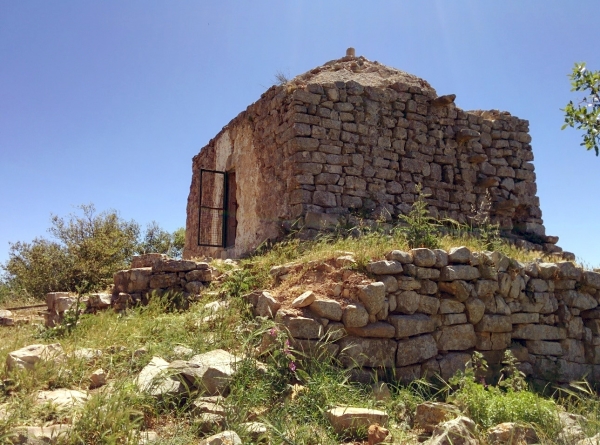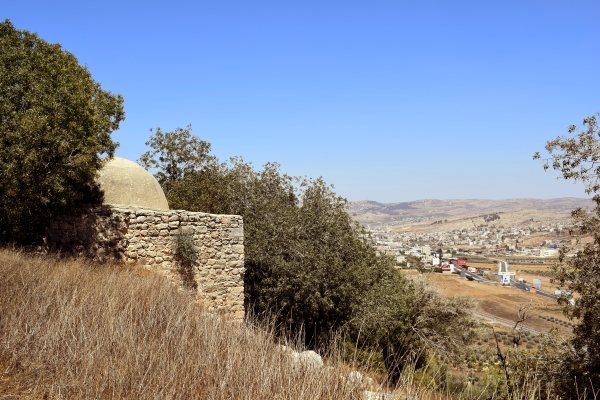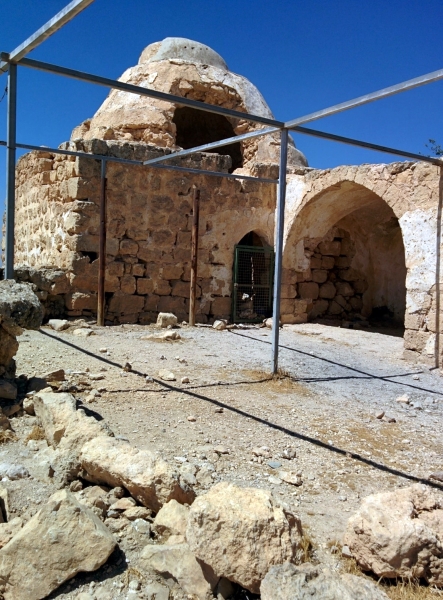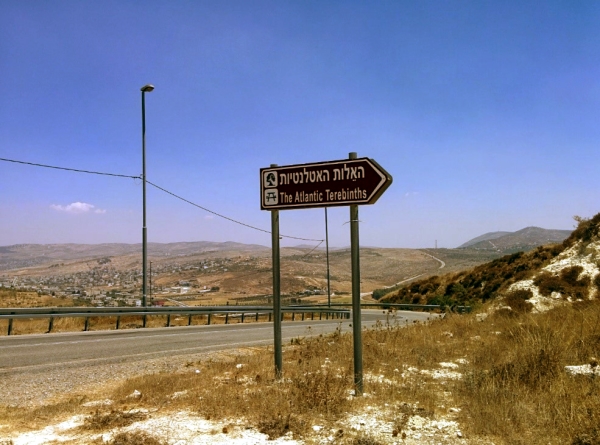Burin (Yitzhar)
10:00 We drove from Rosh HaAyin to Burin for a pre-arranged meeting with Ra’ad Najjar, the head of the Burin local council, and Ayyad Abu Morsi, a council member, and three archaeologists from Emek Shaveh. The meeting had two goals:
- To determine how seriously the village has been harmed by access being blocked to two Moslem heritage sites, one on Jebel Salman (the Salman al Farsi maqqam) and the other on Jebel Isma’il (the Nabi Isma’il maqqam).
- To see whether they’re interested in working with us to make the two sites accessible, so traditional ceremonies may be performed.
Salman al Farsi maqqam, named for a follower of Muhammad, is a traditional two-storey prayer site, adjacent to a cistern and surrounded by an oak grove. It stands on a hilltop bearing its name. The Nabi Ismai’l maqqam has a high dome and it is surrounded by a grove of terebinths beside a neglected, ruined cistern. Villagers have been making pilgrimages to both maqqams, as well as to the Sheikh Ranem maqqam on Mt. Gerizim, praying for fertile wombs and seasonal rain, and celebrating traditional festivals, sons’ first haircuts, etc.
Ayyad abu Morsi, a shepherd, described the strong ties to those locations, and Ra’ad Najjar expanded on his account and described how the children were feeling imprisoned because they’re unable to access the surrounding countryside, enjoy its beauty, pick cactus fruits and red figs, and take advantage of the bountiful springs on Jebel Isma’il and Jebel Salman.
When the Yizhar settlement was established in 1983 on Jebel Salman the Salman al Farsi maqqam was penned within its boundaries. Since then villagers have been unable to reach it. The site, which we have visited and photographed, requires immediate conservation and maintenance. The National Parks Authority, which is responsible for the site, not only fails to restore it but has also removed its name from the sign, which now reads ‘Yizhar Oaks.”
The condition of the Nabi Isma’il maqqam on Jabel Isma’il, at the foot of the Bracha settlement, is no better. The sign reads “Mastic trees.” Palestinians don’t dare approach either the maqqam or the Ein Mahne spring at its foot because they fear the settlers. The settlers took over the spring illegally and built a heart-shaped pool in memory of a settler’s brother who had been killed in Lebanon.
What can be done to allow the villagers to maintain their traditions at the maqqams? How can the cynical strategy of the National Parks Authority, which takes advantage of the fact that the Palestinians are prevented from accessing their holy sites and seeing the terrible condition they’re in, be exposed?
These nature preserves, like many others, exist de facto but not officially, because of “political” considerations. According to the Oslo agreements, Israel cannot officially declare an area a nature preserve without the agreement of the Palestinian Authority. On our next shift we’ll discuss with Issa Suf from Hars whether to contact the Authority.
The six villages whose lands were stolen to establish Yizhar – Burin, Madama, Asira al Qabaliya, Huwwara, Inabus and ‘Arif – maintained the tradition of pilgrimages and celebrations at Salman al Farsi. Two or three months ago we began a project to document the tradition with video interviews in Burin, and we’ll continue in the other villages.
There are, in general, four types of Moslem holy sites in the area under Israeli occupation:
- The primary one, of course, is the Al Aqsa mosque and the well-publicized conflict over access.
- Maqqams which are holy to both Jews and Moslems, like in the Palestinian villages of Awwarta or Kifl Hars which are subject to invasions by masses of Jewish settlers in coordination with the army, but which are normally accessible to the villages. Or like the Cave of the Patriarchs where an organized time-sharing arrangement is in place.
- Maqqams that have been taken over by the Jewish narrative, such as Rachel’s Tomb, Joseph’s Tomb and others with biblical names, to which Jews, Moslems and even Christians once made pilgrimages.
- Undeniably Moslem maqqams, such as the ones under consideration here. There are a few others in the Nablus area beside Salman al Farsi and Nabi Isma’il – Sheikh Bilal, trapped in Alon Moreh, and Sheikh Ranem on Mt. Gerizim. I assume there are others which we haven’t reached yet.
The view of the occupation we can see from the hilltops and the maqqams trapped inside Jewish settlements provides a perspective additional to the one we get from the roads and the checkpoints.
The view from the top of Mt. Kabir (Mt. Bilal) and Alon Moreh over Nablus below is a difficult sight. Nablus, the regional capital, is imprisoned and separated from the Palestinian villages around it. The same strategy separating the villages from the hills and the holy sites also separates the regional capital from its villages. It divides farmers with their agricultural traditions from the urban consumer. These divisions intentionally and consciously destroy the Palestinians’ fabric of life and venerable cultural and agricultural traditions. Nablus, once a city surrounded by villages, has become a city surrounded by Jewish settlements. The city is choking, poor, containing two refugee camps with no access to the hills and prayer sites.




